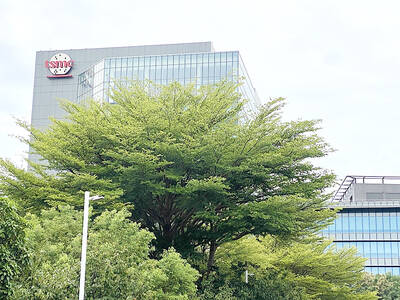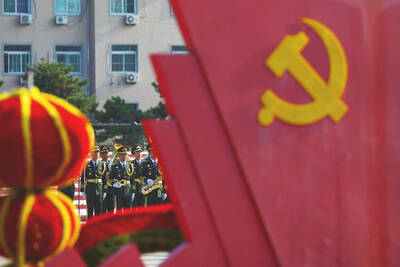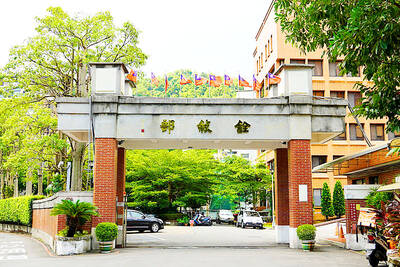The interval between big earthquakes in Taiwan could be about a decade, if 10 recently discovered active faults in the south are taken into account, geologists at National Taiwan University (NTU) said yesterday.
After more than 2,400 lives were claimed by a 7.3 magnitude temblor in Taiwan on Sept. 21, 1999, Taiwanese geologists and seismologists began to review all active faults in a bid to find signs of when the next big earthquake might be.
By digging trenches along the Chelungpu Fault (車籠埔斷層), site of the disastrous 921 earthquake, Chen Wen-shan (陳文山), a NTU geosciences professor, has spent almost four years trying to discover the average period between the fault's dramatic movements.
"According to our studies, we conclude that the interval between the Chelungpu Fault's dramatic movements is between 350 and 400 years," Chen said yesterday at a press conference.
In other words, Chen said, Chelungpu could be regarded as one of the less threatening faults in Taiwan now, because accumulated energy has been released.
But Chen and his team discovered 10 faults in the plain between Chiayi and Kaohsiung.
Together with 42 active faults announced by the Central Geological Survey under the Ministry of Economic Affairs, Chen said, more than 50 active faults across Taiwan island might cause a devastating earthquake about every 10 years.
"Experiencing big earthquakes is the common destiny of people living in Taiwan, one of the most dangerous earthquake-prone areas in the world," Chen said.
Chen said the government should strongly support the survey on the activities of faults near urban areas and science parks and set up geology-related laws to regulate land use in areas near active faults.
Chen said that, at 1,600 people per square kilometer, Taiwan ranks eighth in the world in terms of population density.
"If we can't avoid using land near active faults, great casualties caused by earthquakes can be expected," Chen said.
Seventeen scientists are involved with the NT$30 million research, which is provided by the National Science Council and the Ministry of Economic Affairs.
Geologists yesterday reminded residents that the frequency of large earthquakes was unpredictable. Taiwan experienced earthquakes measuring more than 7 on the Richter scale in 1935, 1941, 1946 and 1951.
NTU scientists said people should be alert to the threats posed by earthquakes and strengthen the earthquake resistance of buildings.
"Western Taipei could be disastrously struck by a big earthquake if a nearby fault moves," said Chen Yue-gau (
However, not everyone agreed with the scientists' conclusions.
Deputy Director General of the Central Weather Bureau Shin Tzay-chyn (
He said people should be aware of the dangers earthquakes pose because, "after all, we can't avoid living in earthquake-prone areas."
The NTU scientists said that they would focus on faults in eastern Taiwan. The economics ministry's Central Geological Survey designated 25 faults that potential threaten to produce earthquakes.

Taiwan Semiconductor Manufacturing Co (TSMC, 台積電) is expected to start construction of its 1.4-nanometer chip manufacturing facilities at the Central Taiwan Science Park (CTSP, 中部科學園區) as early as October, the Chinese-language Liberty Times (the Taipei Times’ sister newspaper) reported yesterday, citing the park administration. TSMC acquired land for the second phase of the park’s expansion in Taichung in June. Large cement, construction and facility engineering companies in central Taiwan have reportedly been receiving bids for TSMC-related projects, the report said. Supply-chain firms estimated that the business opportunities for engineering, equipment and materials supply, and back-end packaging and testing could reach as high as

CHAMPIONS: President Lai congratulated the players’ outstanding performance, cheering them for marking a new milestone in the nation’s baseball history Taiwan on Sunday won their first Little League Baseball World Series (LLBWS) title in 29 years, as Taipei’s Dong Yuan Elementary School defeated a team from Las Vegas 7-0 in the championship game in South Williamsport, Pennsylvania. It was Taiwan’s first championship in the annual tournament since 1996, ending a nearly three-decade drought. “It has been a very long time ... and we finally made it,” Taiwan manager Lai Min-nan (賴敏男) said after the game. Lai said he last managed a Dong Yuan team in at the South Williamsport in 2015, when they were eliminated after four games. “There is

Democratic nations should refrain from attending China’s upcoming large-scale military parade, which Beijing could use to sow discord among democracies, Mainland Affairs Council Deputy Minister Shen You-chung (沈有忠) said. China is scheduled to stage the parade on Wednesday next week to mark the 80th anniversary of Japan’s surrender in World War II. The event is expected to mobilize tens of thousands of participants and prominently showcase China’s military hardware. Speaking at a symposium in Taichung on Thursday, Shen said that Chinese Minister of Foreign Affairs Wang Yi (王毅) recently met with Indian Prime Minister Narendra Modi during a visit to New Delhi.

FINANCES: The KMT plan to halt pension cuts could bankrupt the pension fund years earlier, undermining intergenerational fairness, a Ministry of Civil Service report said The Chinese Nationalist Party (KMT) caucus’ proposal to amend the law to halt pension cuts for civil servants, teachers and military personnel could accelerate the depletion of the Public Service Pension Fund by four to five years, a Ministry of Civil Service report said. Legislative Speaker Han Kuo-yu (韓國瑜) on Aug. 14 said that the Act Governing Civil Servants’ Retirement, Discharge and Pensions (公務人員退休資遣撫卹法) should be amended, adding that changes could begin as soon as after Saturday’s recall and referendum. In a written report to the Legislative Yuan, the ministry said that the fund already faces a severe imbalance between revenue